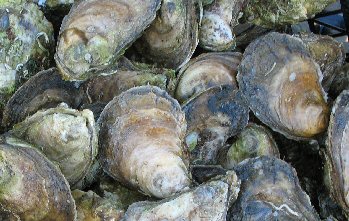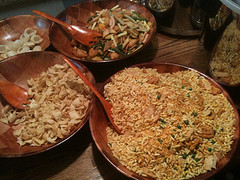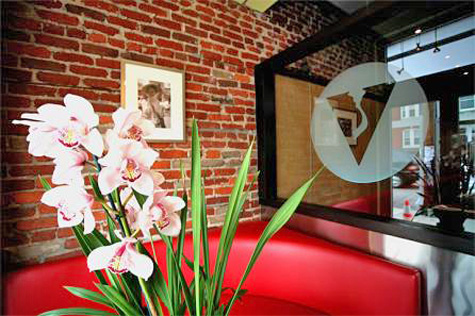For Inquirer columnist Rick Nichols, food is just the beginning of writing about food
By Mallimalika Gupta
Rick Nichols starts his day with a bowl of freshly made Irish oatmeal. He grinds the oats, toasts some pecan and walnuts and adds them into the mix. Then, some maple syrup made by friends in Vermont, a dash of cinnamon from Vietnam (“It is the best cinnamon there is.”), and just a tiny bit of milk.
For lunch, Nichols will sample three different kinds of oysters – a Wellfleet, Chinqueteague and Penniquid, have a bowl of fish chowder, and a little toasty roll stuffed with fried Ipswich belly clams. Over the course of the day, Nichols will also eat Chaat at an Indian restaurant, sample spring rolls and nibble on grape leaf-covered beef, among other items on the BBQ platter at a Vietnamese restaurant.
At Sansom Street Oyster House in Philadelphia, Nichols tips open a deep-cut Wellfleet oyster from his plate. He takes the top off, cuts the muscle. Holding on to the bottom cup of the oyster ever so delicately, he tips it into his mouth, taking in the salty, protein-y liquid with a slight whoosh sound. “It’s like drinking the ocean”, he says.
Rick Nichols is food columnist for Philadelphia Inquirer and drinking the ocean is part of his job.
For someone who writes, talks, thinks and breathes in food, Nichols is not very interested in the actual “food” part of his job. “It’s not what’s on the table,” he explains, “It’s who’s around it.” For Nichols it’s the baker that kneads his dough, the soup maker who cuts the carrots for his soup, and the elementary school children who grow mint leaves for a chocolate shop. It is the people and issues connected to food that matter to him.
From Sansom Oyster House, Nichols walks to the Inquirer office on North Broad Street, the one that is, as he puts it, “white like a wedding cake”.
* * *
At the paper, Nichols’ workspace is an explosion of books on everything food related. The hardcovers, paperbacks, and magazines stretch beyond his cubicle and spill onto a 6 foot shelf next to it. Cooking from Quilt Country, The Book of Chocolate, Pomp and Sustenance, Chinese Kitchen, Food Matters are some of the titles. A large Styrofoam avocado rests on the top of the shelf.
Nichols recalls that the Styrofoam avocado came bearing free samples of guacamole a long time back. A food writer also gets constantly hounded by food.
 The latest among these gifts is caffeinated beef jerky. “Perky Jerky is the world’s first all-natural performance enhancing meat snack” says the packet. “It’s America gone wild,” says Nichols.
The latest among these gifts is caffeinated beef jerky. “Perky Jerky is the world’s first all-natural performance enhancing meat snack” says the packet. “It’s America gone wild,” says Nichols.
Among these and other samples lies his chef hat, the one that he jokes he was given when he graduated from chef school.
He puts it on, turns toward his computer screen (a picture of him with his five grandkids at the last family vacation in Vermont), in order to do some ‘serious work’ as he puts it, indicated by the fact that he has his construction paper-made chef hat on.
Soon, Inquirer’s food critic, Craig LaBan and the food editor, Maureen Fitzgerald put on their paper chef hats too and join in the mock ritual of doing ‘serious work’.
Nichols, who is 63, has worked at The Inquirer for 31 years, all of which were not devoted to writing about food. As a reporter, he covered politics, war in Central America, and social conflict. Then he worked as a writer on the editorial page.
While working on the editorial page he occasionally wrote articles about seasonal produce that were very well received. His editors then asked him to write a food column for the Inquirer magazine. In 1998, he began writing a food column for the main newspaper, too.
Since then he has been writing two columns a week, switching to writing both columns for the newspaper when the magazine was discontinued. His columns appear Sundays and Thursdays.
For those that have not read his columns, his humor coupled with nostalgia and a sense of the romantic is a trademark of his writing style. He takes you through a journey, and makes you see what he sees beyond the table.
Nichols is regularly featured in ‘Best Food Writing’, a series of books published annually, edited by Holly Hughes.
* * *
Nichols’ early evening stop is at University City, Desi Chaat House. He got an email tip from a reader, asking him to check out this new Indian place.
Desi Chaat is a tiny restaurant on the corner of 501 S 42nd Street in a largely residential part of west Philly. “Be cool,” he says before he walks in.
Behind a glass counter is the owner, Syed Bukhari, mixing sauces into a big bowl. Nichols surveys the place. On display behind the glass counter- sauces, yogurt, chickpeas, samosas. In the fridges on the side – Snapple, Lassi, Coke, water. On the opposite wall – four wrought iron chairs looking out onto the street through the glass windows. 
Nichols reads out from a blackboard on the wall. ‘Pani Puri. Paapri Chaat. Aloo Chaat. Samosa Chaat.’ Most of this is new to him. The south Asian man next to Nichols, dressed in business clothes, is busy talking to someone in an undecipherable language on his Bluetooth as he waits for his food. Nichols is not deterred.
He smiles at the man, Bluetooth man smiles back.
“Do you come here often?” says Nichols
“Yes”
“What did you order?”
“One order of Paapri Chaat and one of Samosa Chaat.”
Nichols takes his word for it, and places the same order for himself. Bukhari seems pleased.
Bluetooth man goes back to his telephonic conversation, and our Food man continues his quest for more information. As Bukhari who is from Lahore, Pakistan, mixes ingredients for Chaat, Nichols has questions for him.
Nichols picks up one brown, tortilla like chip from a bowl of ingredients placed on the counter.
“Pardon me, what is this made of?” Nichols asks.
“It’s normally lentils or chickpea flour,” Bluetooth man offers.
Bukhari smiles, and waits for a minute before he divulges. “Skin egg roll.”
“What?”
“Skin egg roll. Egg roll skin.”
Nichols’ excitement is hard to miss. “Egg roll skin – like the one they use in Chinese food?”
“Yes” Bukhari says.
Nichols reconfirms. “So, just so I am clear, you fry egg roll covering and use it here?”
Bukhari nods; Nichols pulls out a pen and scribbles on the pink takeout menu.
Rick Nichols does not like being called a foodie. “I hate the word foodie“, he says. “It speaks to an obsession with the status of food.”
Food to him is entertainment, it is fun. It is about sport, comedy, adventure. It is the sensitive and respectful production of crops. Food itself represents many things. The egg roll covering served in Chaat is therefore a great find, something that speaks of the multiculturalism of food – a world where egg roll skin from a Chinese restaurant is used in Chaat at an Indian restaurant. The story that goes beyond the dish he is served.
Nichols lives for these stories – the man that grows pawpaws in his backyard, the sweet potato pie recipe George Washington Carver came up with, two cookbook writers celebrating Thanksgiving.
“I use food as my prism to talk about other issues,” he explains. “It’s a good way to get people to read about it because everyone eats, right?”
Savouries, chickpeas, boiled potato-cubes, tamarind sauce, chutney, yogurt, chopped onions, tomatoes, raw mangoes and egg roll skin. Nichols mixes them together at Desi Chaat, making sure the sauces and yogurt are well spaced out.
“How do you like it?” He asks a young, white, backpack-and-glasses student sitting in one of the other three chairs looking out at the road.
“It’s good. Nothing beats Vik’s though,” says the young man, a biochemistry student at University of Pennsylvania.
Nichols scribbles down a tiny ‘Viks’ onto the pink takeout menu. He asks Bukhari how business has been.
“It’s pretty good,” he smiles.
Nichols is ready to leave, he might come back later. Before he leaves, he makes sure to get a receipt. The receipt, one of many that he will submit to the Inquirer, will add up to the five to six thousand dollars a year that Nichols spends on food.
* * *
Nichols does not always reveal his identity as food writer for the Inquirer at the outset. A lot of times, he says, people recognize him. He’s been around long enough, and they run a little picture of his inquisitive face, complete with glasses and silver hair with his columns. If they looked at the philly.com website, they might have even seen him in a video on the food page – 5’11, average build and the silver hair. When he wants to write about a place, he goes and introduces himself.
“I don’t want to be vicious, or anything. I want to tell people the story of the cuisine or the family,” he says. For that, he doesn’t need cover.
Nichols’ next stop is Vietnam Café. The story that waits for him there is about the American journey of the family that owns the restaurant.
The family moved to Philadelphia after fleeing Vietnam in 1978. With their savings they first opened a grocery store at University City in West Philadelphia. Soon after, they opened a tiny restaurant at North 11 Street in Chinatown. The family of husband, wife and eight kids worked hard to keep the two businesses running. Then, in a widening familial circle, they opened another restaurant at South 47 Street, next to their grocery store, and called it Vietnam Café. This year, they bought the place next to the Café and expanded into a larger restaurant with a banquet hall. 
“No one in Philly said, ‘Gee, I wish I had lemon in my soup’. Or asked for vermicelli noodles or spring rolls,” Nichols said. “There was a war halfway across the world, and these people moved here and brought their culture with them.”
“And now we have spring rolls even on the menus of French restaurants.”
Benny Lai, the owner of Vietnam Café, is a small, friendly man. As soon as Nichols walks in, he rushes out from behind the bar to greet him. They have known each other for several years.
Vietnam Café is new, that you can tell. The floors, the tabletops, the bar counter; the walls have that shiny new air to them. The low lighting reflects off of the red walls to create a red glow in the place. The lanterns in greens, yellows and oranges are the canopy overhead.
Nichols is drawn to a picture on his right as he enters the restaurant – three women in traditional garb threshing rice husks,
“Is this from the time when women used to be the men?” Nichols asks.
Lai laughs. “Yes. They would thresh the rice in the fields, and when some of it fell out of the wooden boat into the fields, it would be eaten by animals.”
“And that’s why you have the duck here!” Nichols picks up the model of a white duck with a pointed orange beak sitting on top of a cabinet looking at the picture on the wall.
Nichols follows Benny Lai for a quick trip of the kitchen. The silver of the oven and kitchen appliances compete with the white of the floors and walls. A quick sampling of mustard tofu being marinated for Vietnamese hoagies sold at the grocery store, a quick look at chicken being sautéed, and he is ready to be seated.
As he waits for his BBQ platter (Crispy Spring Rolls, Beef Stuffed Grape Leaves, Char-grilled Chicken, Grilled Meat Balls, Rice Vermicelli, Lettuce and Rice Paper), Benny Lai tells him about the family.
Nichols used to have lunch at the 28-seater Vietnam Restaurant in Chinatown with his friend David Zuchhino, war correspondent for the Inquirer 16 years back.
A lot has changed since – the family has this new place, their father has retired, his siblings all have their own successful businesses: Dave runs the grocery store, Nick is a patrolman, Ken has a dry-cleaning place in South Philly, Ricky opened Vietnam Grill in Charlotte, NC, Tina helps run the Vietnam Restaurant. The family of 10 that lived in a two bedroom apartment across the road from Vietnam Café has had quite a journey. The story, again, goes beyond spring rolls and noodles. It is the turn of events in the lives of these immigrants.
The platter soon arrives. Nichols is most excited by the slivery thin rice cakes served alongside. He carefully separates one from the other – these babies get sticky – adds a chopstick-full of vermicelli noodles, some chicken, one mint leaf. Rolling it requires expertise. He pushes the food back to the edge of the cake, folds in the sides, rolls it upwards, and he’s ready to dip it in the two sauces provided.
“Sixteen years later, and he still knows how to roll a rice cake,” says Benny Lai.
Pennsylvania Dutch is his origin. His soul food then, is chicken pot pie, German potato salad, corn soup. Yet, he rolls rice cakes like a pro.
“I am a pretty good reporter,” says Nichols. “I do not know these things at the top of my head. I never went to culinary school.” Nichols says he goes out, talks to people and finds out about things. That is how he learnt about Vik’s, that is how he learnt to roll his race cake, and that is how he writes about all kinds of food as if it is oozing from his pores.
* * *
Nichols’s dining obligations for the day are done. He is ready to head back home, but not before he swings by Fu-Wah, the grocery store run by Dave, Benny’s brother, and inquires about their hoagies.
The coming Saturday, Rick Nichols will play Scrooge at the Dickens Winter festival in Narberth. He has a new catch phrase for his character – Destroy Joy. There is little about Rick Nichols that indicates he is capable of destroying joy.
We hear that the festival will have lots of kids, waiting to take pictures with the costumed characters. Nichols will enjoy that.
There will be hot toddies served at the three pubs in Narberth. Nichols will like that.
There will be vendors selling wreaths, handmade soaps, buttons, pumpkin bread, and homemade turkey soup. Nichols will taste the soup, bite a piece off the bread and sip on the toddies, but most of all he will revel in the flavours of the season, rejoice this coming together of the entire community to celebrate the spirit of the holidays, and enjoy himself in the countless conversations he will have.
For Rick Nichols, the anti-foodie lover of food, what’s around the table that day will be something to cherish.
